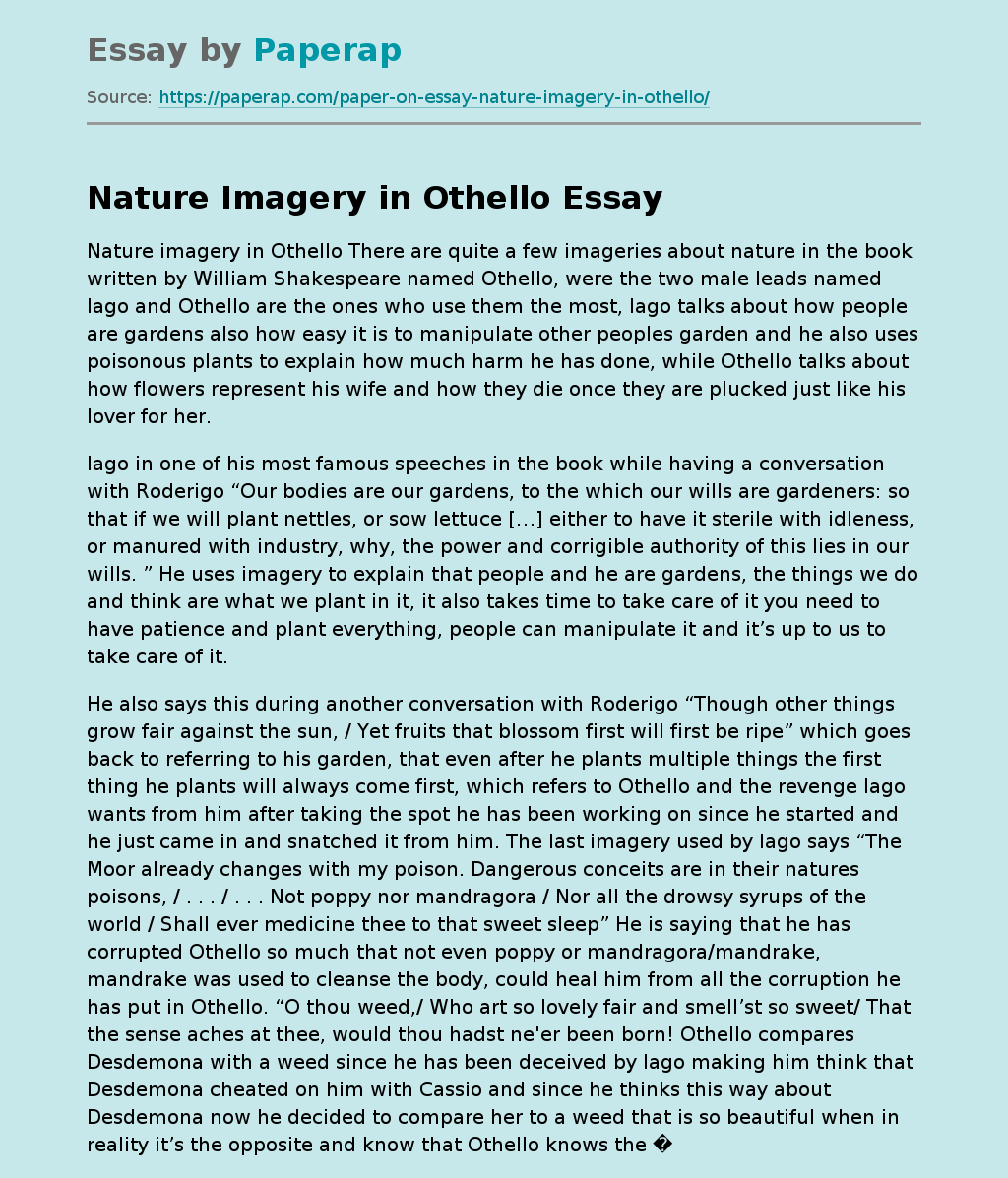Nature Imagery in Othello
Nature imagery in Othello There are quite a few imageries about nature in the book written by William Shakespeare named Othello, were the two male leads named Iago and Othello are the ones who use them the most, Iago talks about how people are gardens also how easy it is to manipulate other peoples garden and he also uses poisonous plants to explain how much harm he has done, while Othello talks about how flowers represent his wife and how they die once they are plucked just like his lover for her.
Iago in one of his most famous speeches in the book while having a conversation with Roderigo “Our bodies are our gardens, to the which our wills are gardeners: so that if we will plant nettles, or sow lettuce […] either to have it sterile with idleness, or manured with industry, why, the power and corrigible authority of this lies in our wills. ” He uses imagery to explain that people and he are gardens, the things we do and think are what we plant in it, it also takes time to take care of it you need to have patience and plant everything, people can manipulate it and it’s up to us to take care of it.
He also says this during another conversation with Roderigo “Though other things grow fair against the sun, / Yet fruits that blossom first will first be ripe” which goes back to referring to his garden, that even after he plants multiple things the first thing he plants will always come first, which refers to Othello and the revenge Iago wants from him after taking the spot he has been working on since he started and he just came in and snatched it from him.
The last imagery used by Iago says “The Moor already changes with my poison. Dangerous conceits are in their natures poisons, / . . . / . . . Not poppy nor mandragora / Nor all the drowsy syrups of the world / Shall ever medicine thee to that sweet sleep” He is saying that he has corrupted Othello so much that not even poppy or mandragora/mandrake, mandrake was used to cleanse the body, could heal him from all the corruption he has put in Othello. “O thou weed,/ Who art so lovely fair and smell’st so sweet/ That the sense aches at thee, would thou hadst ne’er been born! Othello compares Desdemona with a weed since he has been deceived by Iago making him think that Desdemona cheated on him with Cassio and since he thinks this way about Desdemona now he decided to compare her to a weed that is so beautiful when in reality it’s the opposite and know that Othello knows the “real” Desdemona she will now wish she was never born since Othello is going to get revenge from all the “wrongs” she did to him.
On the last scene where Othello kills Desdemona he comes to her chamber and sees her sleeping, he tells her “When I have plucked thy rose/ I cannot give it vital growth again,/ It must needs wither” What Othello means is that after he kills her there is no going back, he uses a rose that once that rose is plucked it starts to slowly die and there is no way for the rose to stop from dying which is what is happening here.
This can also signify the love that he has lost for Desdemona since she cheated on him with Cassio, when Othello plucked Desdemona’s love from his heart and it can never grow back again, since he doesn’t want for her to do this again he decides to kill her just like a flower will die from being plucked.
The night that Desdemona was going to be murdered by Othello she sang the willow song “The poor soul sat sighing by a sycamore tree, Sing all a green willow: Her hand on her bosom, her head on her knee, Sing willow, willow, willow: The fresh streams ran by her, and murmur’d her moans; Sing willow, willow, willow; Her salt tears fell from her, and soften’d the stones; Lay by these:– Sing willow, willow, willow; Prithee, hie thee; he’ll come anon:– Sing all a green willow must be my garland. Let nobody blame him; his scorn approve,- Nay, that’s not next. -Hark! who is’t that knocks? ” Willow trees are often associated with mourning and grief, which is why they are often called weeping willow, which fits perfectly to what Desdemona is feeling. Desdemona singing this song reflects how she is feeling about Othello, even though she is being accused for something that isn’t true she doesn’t say that he is wrong, even when she knows that he is, she goes along with what he says because she loves him so much, even though it hurts her to be thought like that by the love of her life.
When I first read the book Othello, I didn’t pay attention to the references about nature that William Shakespeare used in this particular text, after reading it and getting this assignment I decided to go back and re-read it on my own. After reading the book I noticed that the main characters used plants to explain what they were feeling or going through, for someone to be able to understand and catch on to all of this one needed to be very oriented in nature.
Nature Imagery in Othello. (2019, Jun 20). Retrieved from https://paperap.com/paper-on-essay-nature-imagery-in-othello/

